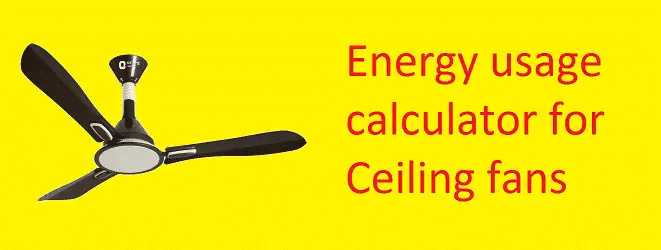Ceiling fans are used to circulate air inside a closed space. Even though they do not cool down the air, the continuous circulation of air helps us feel better. The power consumption of ceiling fans is fractional when compared to that of air conditioners. The energy usage of ceiling fans, electricity bill and the daily, monthly and yearly energy consumption of your fan can be calculated using this tool.
Ceiling fans are very common residential and commercial load. It is a basic single phase induction motor or a BLDC motor fitted with blades. The power consumption of ceiling fans ranges between 30 watts to 110 watts.
Enter the wattage, hours of usage and cost per kWh. This electricity usage calculator for ceiling fan gives you the total energy consumed by the fan and the utility charges.
Energy usage of ceiling fans
| Wattage: | |
| Average usage hours per day: | |
| Cost per unit*:(Global Electricity rates) | |
| Electricity usage per hour: | |
| Electricity usage per day: | |
| Usage cost per hour: | |
| Usage cost per day: | |
| Usage cost per month: | |
| Usage cost per year: |
Terms and definitions:
Wattage:
Power usage of the device in watts as mentioned on its label.
Cost per unit:
The average cost per unit charged by the electric utility. Every country has different tariff rates. Visit: Global Electricity prices for details if you don’t know how much the utility company charges you per unit or kWH.
Units per day:
The number of units of electricity consumed by the load every day considering the entered operation hours.
Hours of usage:
Number of hours the load is used per day.
The electricity usage depends on the wattage, number of hours of usage. The utility company charges you for total number of kilo-watt-hour of energy you have consumed. Kilowatt hour is the product of power consumption of the load and the number of hours of usage.

The origin of ceiling fans is believed to be from India. They used huge leaves hung from the ceiling to move the air to and fro. Such fans were known as pangahs. Nowadays ceiling fans are motor-driven.
A ceiling fan basically consists of an electric motor (either single-phase induction motor or a brushless DC motor) fitted with metallic or wooden blades. There are a huge variety of ceiling fans available in the market. They find their applications in homes, commercial building etc. High volume low-speed fans normally known as HVLS are huge ceiling fans found in malls, restaurants and railway platforms.
The power consumption of a ceiling fan depends upon a few factors such as its load(weight), age, and speed control methods. Today semi-conductor-based speed regulators are available in the market which is very energy efficient and helps us save a lot of energy.
Typical power consumption of ceiling fans
As mentioned earlier the power consumption of ceiling fans ranges between 30-110 watts. This may vary from manufacturer to manufacturer and from one model to the other.
Air conditioner Electric iron LED bulbs CFL Lamps Ceiling fans Clothes Dryer Dishwashers Microwave oven Vacuum cleaner Refrigerators Water heater Hairdryer Toaster Coffee maker Electric kettle Blender Mixer grinder Juicer Space Heater Air Purifiers Deep fryer Freezers Induction cooktop Xbox & PlayStation Rice cooker Steamer Cooker hood Exhaust fans Humidifier